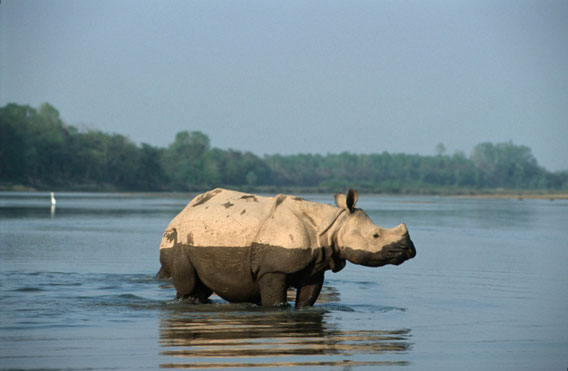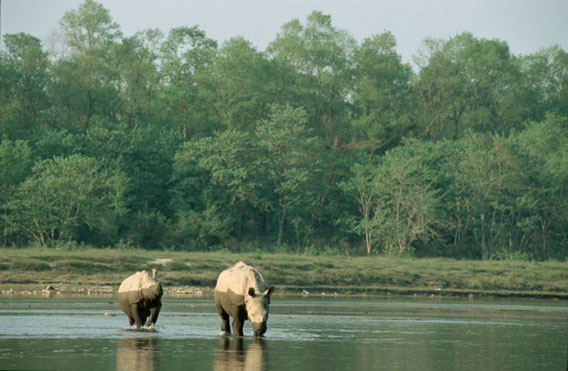
Greater one-horned rhino in Nepal. Photo courtesy of WWF.
As rhinos again fell to poachers in record numbers in 2011, there was one bright-spot: Nepal. Not a single rhino was killed by poachers in the Himalayan nation, home to an estimated 534 greater one-horned rhinos (Rhinoceros unicornis), categorized as Vulnerable by the IUCN Red List. Conservationists celebrated at Chitwan National Park, which holds the vast majority of the country’s rhinos.
“This is the first time in 29 years that Nepal has gone an entire year without a single poached rhino, and it’s a testament to the efforts of the Government of Nepal, WWF and many partners,” said Barney Long, Asian species expert at WWF. “We hope the new year will bring additional good news from other countries like South Africa as they continue to crack down on rhino poaching.”
South African rhinos have been decimated over the past few years with 2011 marking a new record of butchered rhinos: 448. Poachers shoot rhinos and saw off their horns (often while still alive) in order to sell the horns in the black-market traditional Asian medicine trade. However, research into the horns has proven time-and-again that they have no medicinal value.
Greater one-horned rhinos are found both in Nepal and India with the bulk in the latter. Researchers estimate a total population of around 2,500. Fortunately this is one of the few rhino species that is thought to be increasing.
Three of the world’s five rhino species are listed as Critically Endangered by the IUCN Red List: the black (Diceros bicornis), the Javan (Rhinoceros sondaicus), and the Sumatran (Dicerorhinus sumatrensis). Less than 50 Javan rhinos survive, all in a single park in Java, while around 250 Sumatran rhinos survive. Last year also marked the announcements of the extinction of two rhino subspecies: the Vietnamese rhino (Rhinoceros sondaicus annamiticus), a subspecies of the Javan, and the western black rhino (Diceros bicornis longipes), a subspecies of the black.
Beyond pushing one of the world’s most iconic animals to extinction, the poaching trade has a human and societal toll: poachers have been killed in the act, while wildlife guards have lost their lives protecting rhinos. Still the criminal mafia at the top of the illegal trade remains largely unpunished.

Greater one-horned rhinos in Nepal. Photo courtesy of WWF.
Related articles
South Africa hits record poaching of rhinos—again
(11/03/2011) Two months before the end of the year, the number of rhinos killed for their horns in South Africa has surpassed last year’s breaking record, reports conservation organizations WWF and TRAFFIC. So far, 341 rhinos have been lost to poaching this year; while last year saw a total record of 333. The news follows last week’s announcement that the Vietnamese rhino (Rhinoceros sondaicus annamiticus), a subspecies of the Javan rhino, has gone extinct—the last individual killed by a poachers’ bullet. Rhinos are killed for their horns which are used in traditional Chinese medicine, even though numerous studies have shown there is no medicinal benefit to consuming rhino horn.
Camera traps snap 35 Javan rhinos, including calves
(01/04/2012) Camera traps have successfully taken photos of 35 Javan rhinos (Rhinoceros sondaicus) in Ujung Kulon National Park. The small population, with an estimated 45 or so individuals, is the species’ last stand against extinction. Late last year, a subspecies of the Javan rhino, the Vietnamese rhino (Rhinoceros sondaicus annamiticus), was declared extinct.
‘Christmas miracle’ for endangered rhinos
(12/24/2011) Conservationists and wildlife officials in the Malaysian state of Sabah airlifted a young female Sumatran Rhinoceros — one of the world’s most endangered animals — to an area of forest where she would encounter a potential partner, reports the Sabah Wildlife Department and Borneo Rhino Alliance. Sumatran Rhinoceros populations are so low, some individuals live in areas where they have no hope of ever finding another rhino.